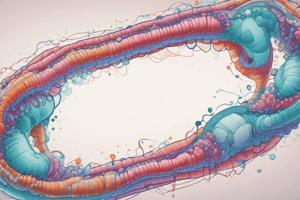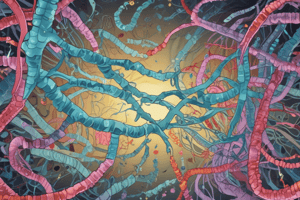Podcast
Questions and Answers
What was the significance of Griffith's experiment in understanding transformation?
What was the significance of Griffith's experiment in understanding transformation?
Griffith's experiment demonstrated that genetic material could be transferred between bacteria, providing evidence for the process of transformation.
Explain the difference between generalized and specialized transduction.
Explain the difference between generalized and specialized transduction.
Generalized transduction involves the transfer of any bacterial gene, while specialized transduction transfers specific genes linked to the prophage.
Describe the role of the F-factor in bacterial conjugation.
Describe the role of the F-factor in bacterial conjugation.
The F-factor is a plasmid that facilitates the formation of a sex pilus, enabling the transfer of genetic material during bacterial conjugation.
What are R plasmids and why are they important in microbiology?
What are R plasmids and why are they important in microbiology?
Identify the main types of mutations and provide one example for each.
Identify the main types of mutations and provide one example for each.
What is the Ames test and what does it measure?
What is the Ames test and what does it measure?
Explain the difference between insertion sequences and composite transposons.
Explain the difference between insertion sequences and composite transposons.
What is the mechanism of replicative transposition in prokaryotic transposable elements?
What is the mechanism of replicative transposition in prokaryotic transposable elements?
How does the regulation of copy number in plasmids impact bacterial genetics?
How does the regulation of copy number in plasmids impact bacterial genetics?
Flashcards
Transformation
Transformation
The process by which a bacterial cell acquires new genetic material (DNA) from its environment.
Bacterial Competence
Bacterial Competence
A state of competence refers to the ability of a bacterial cell to efficiently take up exogenous DNA, providing it with the necessary genetic machinery for transformation.
Transduction
Transduction
The transfer of genetic material from one bacterium to another through a virus (bacteriophage).
Generalized Transduction
Generalized Transduction
Signup and view all the flashcards
Specialized Transduction
Specialized Transduction
Signup and view all the flashcards
Conjugation
Conjugation
Signup and view all the flashcards
Plasmids
Plasmids
Signup and view all the flashcards
Mutations
Mutations
Signup and view all the flashcards
Transposable Elements
Transposable Elements
Signup and view all the flashcards
Study Notes
Transformation
- Zero lecture, Discovery of transformation, Griffith's experiment, Mechanism of transformation
- Factors affecting transformation process
- Competence, Development of competence in S. pneumoniae
- Transduction discovery, Lederberg and Tatum's experiment, Mechanism and types of transduction, Generalized transduction, Specialized transduction, Sexduction, Abortive transduction
Conjugation
- Discovery, Experimental evidence, F-factor, F+ & Hfr
- Mechanism of conjugation, Cross between Hfr, F+ & F-
- Conjugants and its application, Features of T4 genetics, Genetic basis of lytic versus lysogenic switch of phage lambda
Plasmids
- Types of plasmids, F plasmid, R Plasmids, colicinogenic plasmids, Ti plasmids
- Linear plasmids, Yeast micron plasmid, Plasmid replication and partitioning
- Host range, plasmid- incompatibility, Plasmid amplification, Regulation of copy number, Curing of plasmids
Mutations
- Definition and types of Mutations, Physical and chemical mutagens
- Uses of mutations, Reversion and suppression, True revertants, Intra- and inter-genic suppression, Ames test, Mutator genes
Transposable Elements
- Prokaryotic transposable elements, Insertion Sequences, Composite transposons, Non-composite transposons, Replicative transposition, Non replicative transposition
- Eukaryotic transposable elements, Yeast (Ty retrotransposon), Drosophila (P elements), Uses of transposons, Uses of transposition, Revision
Studying That Suits You
Use AI to generate personalized quizzes and flashcards to suit your learning preferences.




